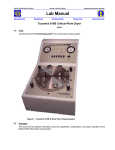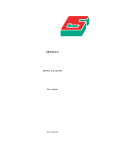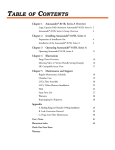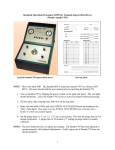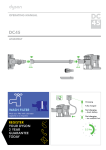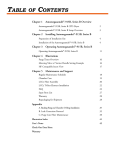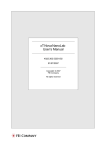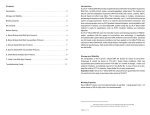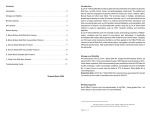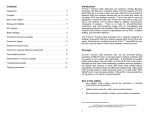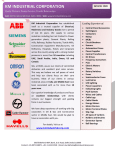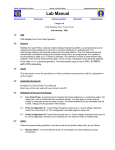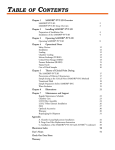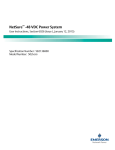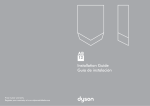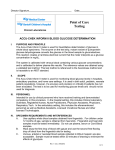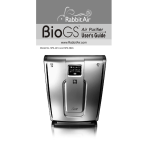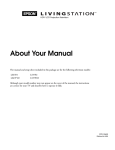Download Tousimis 915B Critical
Transcript
Chapter [2.21] Tousimis 915B Critical-Point Dryer (cpd) 1.0 2.0 Equipment Purpose 1.1 This document has specific information about the capabilities, configuration, and proper operation of the Model 915B critical-point drying system. 1.2 The Automegasamdri-915B (cpd) is a fully automatic CO2 critical point drying apparatus (Figure 5). Its front panel consists of a pressure gauge, a temperature gauge, a purge timer knob, and six process push buttons (COOL, FILL, PURGE, HEAT, BLEED, and VENT) with green LEDs. Only COOL and FILL buttons need to be pushed for a complete process. The unit can also operate under semi-automatic mode, but it is not recommended for the inexperienced users. The sample holders for cpd are available for 2-inch through 6-inch wafers. Holders for the Tousimis 815 (cpd2) can also be used in cpd 1.3 On the flat panel of the unit, there are four micrometer valves that control the COOL, BLEED, FILL and PURGE/VENT flows. They are set during the install, and should not need readjustment. DO NOT ADJUST THE VALVES. Material Controls & Compatibility 2.1 3.0 (382) N. A. Applicable Documents 3.1 Automegasamdri-915B User Manual, Serial Number 1257, Tousimis Inc. 3.2 Tousimis 915B Operating Manual (24 MB PDF file) http://nanolab.berkeley.edu/labmanual/chap2/Tousimis915BOperatingManual.pdf 3.3 Verified Temperature Pressure Graph of Nanolab CPD Process List related documents and vendor’s manuals - http://nanolab.berkeley.edu/labmanual/chap2/PTgraph.jpg 3.4 Pressure vs. Temperature Graph for CPD Process – See Nanolab CPD experimental graph on appendix 11.3. 4.0 5.0 6.0 Definitions & Process Terminology 4.1 CPD: critical-point drying (dryer) 4.2 LCO2: liquid carbon dioxide Safety 5.1 The CPD system normally operates under very high chamber pressures. DO NOT DEVIATE FROM THE CORRECT PROCEDURE FOR LOADING THE SAMPLE AND SECURING THE CHAMBER LID – personal injury is quite possible otherwise. 5.2 An uncontrolled release of CO2 can cause personal injury due to frostbite. Again, DO NOT DEVIATE from the correct procedures. Make very sure that persons near the system are always wearing protective eyeware. Process Data 6.1 7.0 N/A Available Processes, Gases, Process Notes 7.1 CPD uses copious amounts of LCO2. Requests for LCO2 cylinder changes are the primary CPD problem report and result in decreased tool availability for all lab members. Review the following Process Notes and attempt to minimize your LCO2 usage. 7.2 Extra long purge time does NOT increase the effectiveness of your critical point drying process; it just wastes LCO2. 7.3 Minimize the amount of alcohol you add to the chamber. You only need enough alcohol to just cover your parts. 7.4 Maximize the volume of the CPD chamber filled with Teflon inserts. The more Teflon in the chamber, the less alcohol in the chamber, and the less LCO 2 needed. 7.5 Most of the LCO2 is consumed during the PURGE process. Each number of the PURGE dial indicator corresponds to 5 minutes of flowing LCO2; i.e., setting 1 = 5 min, Setting 2 = 10 min, Setting 4 = 20 min, etc. The goal of the purge process is to replace essentially all the methanol/IPA in the chamber with LCO2. Since methanol and IPA are especially soluble in LCO2, there is NOT a linear relationship between purge time and alcohol removal. Most alcohol is removed from the chamber after only one LCO2 volume exchange. Once the alcohol has been removed, the LCO2 can be heated to supercritical conditions and a phase change from liquid to vapor can take place without crossing a liquid/vapor equilibrium line and generating the surface tension forces that result in adhesion of released MEMS parts. (See Section 3, Pressure vs. Temperature Graph for CPD Process). 7.6 Process staff has verified that there was no remaining alcohol and therefore a completely effective CPD process was performed with the following samples and volumes of alcohol. ® ® 4” Wafer Number of wafers Amount of Methanol Purge Setting Cool CO2 Chamber CO2 4 120 ml 4 4.5 lb 10.5 lb 1 40 ml 2 5.0 lb 3.5 lb 6” Wafer Number of wafers Amount of Methanol Purge Setting Cool CO2 Chamber CO2 4 320 ml 6 5.5 lb 13.5 lb 1 80 ml 2 4.5 lb 7.5 lb 7.7 For a single 4” or 6” wafer there is never a need for a purge setting greater than 2. 7.8 CPD is often one of the last steps of a lengthy MEMS process. Users are wary to risk their parts to an ineffective CPD process. If you would like to verify that a lower purge time is suitable for your process – run a dummy process one time. Add a non-critical sample and just enough alcohol to cover the sample. Use the recommended minimum purge time. Verify that the chamber is absolutely dry (no residual alcohol) at the end of the process. If the chamber is dry, you have performed a fully effective CPD process. 7.9 During any CPD run especially during the dummy run prior to CPD of a critical run – Observe the CPD chamber pressure closely during the heat stage. Though the temperature begins to increase before a pressure increase is observed – at no time should you observe any pressure decrease. A pressure decrease during the heating step is likely an indication of a poor seal at the chamber lid and the CPD process may fail. If you observe pressure decrease during heating of your dummy run, allow the run to finish and be sure to replace the chamber o-ring and run another dummy run prior to processing your critical part. Remember to check the LCO2 cylinder weights prior to every run. If you observe pressure decrease during heating of a critical run, do not abort the run – aborting the run will definitely result in CPD process failure. Your run may still complete successfully. Allow the run to finish and note if the run ends normally or with all lights flashing. 7.10 If you ever observe residual alcohol in the chamber using the minimum recommended times, report it as a CPD problem on the Mercury. Important Note: Any residual HF remaining on your samples from previous steps can easily damage the High Pressure Sensor on the cpd tool. Therefore, extra care must be taken to thoroughly rinse off your part(s) before entering the cpd chamber. 8.0 Equipment Operation 8.1 8.2 Preparation 8.1.1 Before starting to use cpd, the user should check the four liquid CO2 cylinder weights that are online. See Figure 2. When any cylinder is below the written weight value on the tape (this is when the weight is 25 lbs or more) below its full weight of LCO2), close that particular cylinder, report a fault on the Mercury and only open the valve on a new LCO2 cylinder if it is on a weekend. This will give the staff adequate time to check, open or add new LCO2 tanks. A full tank provides 30 lbs of CO2 according to the vendor. Therefore, the cylinder has to be changed before 30 lb has been used up. 8.1.2 Clean samples carefully. Photoresist residue may re-deposit on the dried samples or the chamber walls. 8.1.3 Make sure your samples are sufficiently rinsed after a wet process that involves HF and/or other acid treatments, before entering the cpd chamber. 8.1.4 The user should also decide on the purge time beforehand and set the purge timer knob accordingly. A setting of 1 indicates 5 minutes; a setting of 2 indicates 10 minutes; and so on, to a maximum of 45 minutes. See Section 7 for Process Notes regarding appropriate Purge times. Operation 8.2.1 cpd and cpd2 systems share four CO2 tanks; both systems can be used simultaneously. When the tool is enabled, the ON indicator light on the system will be illuminated. 8.2.2 Enable cpd on the Mercury. Note the ON indicator light on top of the tool lights up (Figure 5). The green LED on the VENT button (on the cpd console) will go on. This means the unit is in the vent mode. 8.2.3 Verify that the cylinder valves of four out of six liquid CO2 cylinders are open. Check the weights of the cylinders. Six liquid CO2 cylinders are located at the back wall of chase 383. Each cylinder is labeled with the CO2 + the cylinder weight on top of the read out gauge. When the read out on the cylinder weight gauge is the same as the posted tape value, close that cylinder, report a fault on the Mercury and only open the valve on a new bottle if it is on a weekend. Report a fault on the Mercury immediately after you close a valve. The weight should be checked after each run. 8.2.4 Record the weight of the CO2 cylinders (see 8.2.24 below). 8.2.5 Remove the eight steel nuts and eight bronze washers from the chamber lid. Place a clean Techni-cloth or two on the table top. Using the index fingers of both hands, insert your fingers into the loops on the lid and lift the lid from the chamber and place it onto the Techni-cloths. The lid is heavy – do this slowly and carefully. Do not allow the lid bottom to contact the top of the steel bolts – the bolts will scratch the lid sealing surface and cause it to leak. 8.2.6 Remove the four Teflon spacer rings from the chamber (Figure 6). Remember to wear ® poly gloves (clear) when you are handling Teflon spacer rings. 8.2.7 Clean the chamber using methanol/IPA and dry with N2 gun. Repeat several times if necessary. Do not use the Teri towels in the lab from 582A – they shed lint, and the lint will end up all over your sample as well as the chamber. This has been experimentally verified. Do not use Techni-cloth cleanroom wipes from the lab either because they shed lint also. Only use Synthetic Wipers by cpd and cpd2. Please cut them into small pieces and use only what you need because they are very expensive. Refit the appropriate ® Teflon spacer rings back into the chamber: ® Sample Rings to Use 6” wafer None 4” wafer One (the largest) 3” wafer Two largest 2” wafer Three largest Something smaller All four 8.2.8 As you replace the rings into the chamber, wipe them down with a Techni-cloth and IPA/methanol. Note that when all four rings are in the chamber, the available sample size is the same as for cpd2. 8.2.9 Place only enough Methanol or IPA into the chamber to cover your sample(s). More alcohol requires a longer purge time (see 8.1.3), and thus more CO2. ® 8.2.10 Place your sample(s) in the chamber. There are five Teflon sample holders available: 6”, 4”, 3”, 2”, and pieces-parts basket. The sample holders are stored in a drawer below the cpd systems. Alternatively, some users have custom sample holders, and in fact the system can be used without any sample holder at all, by placing the sample on the bottom of the chamber. Sample holders from cpd2 can also be used. Be careful to keep the surface of the sample wet while transferring it into the chamber. Practice and experience are very helpful here. 8.2.11 Place the lid on the chamber. Take great care to avoid allowing the bottom of the lid to make contact with the top of the steel studs. Once the bolt holes in the lid line up with the studs, as viewed from directly above, carefully lower the lid into place. 8.2.12 Press the COOL button. The LED on the button will go on (VENT LED will go off). The unit will go on cooling by itself until slightly below 0°C. If it takes more than 2 minutes to reach 0°C, the COOL LCO2 cylinder may be depleted. Note that we could easily have begun the cool down cycle before placing the lid on the chamber. Why might this be a bad thing? If we were to cool down the chamber before installing the lid, we run the risk of condensing moisture from the lab air. By cooling the chamber after placing the lid in place, we minimize that risk. The cool down takes only a couple of minutes anyway, so time savings is not an issue. 8.2.13 Replace the eight bronze flat washers, then replace the eight steel nuts, but do not tighten them past gentle contact. 8.2.14 Using the Ft Lb torque wrench, and working in a star crossing pattern, begin tightening the nuts one at a time. It is critically important to tighten the bolts evenly to avoid leakage and damage to the lid or the chamber. See Figure 7. Make two passes around the lid in the star pattern. Proper tightening does not require a lot of force – don’t try to kill it! When all steel nuts are snug tight, readings should be about 5 to 6 Ft Lb. 8.2.15 Verify that the chamber temperature has reached 0° C, and then press the FILL button. The unit will start filling the chamber with liquid CO2. The user can see a visible liquid flow through the fill port. If not, the CHAMBER LCO2 cylinder may be depleted. Now the unit is in the AUTOMATIC mode. It is not necessary to push any more buttons until the process has completed. 8.2.16 After 8 minutes, the unit switches to PURGE Mode automatically. The PURGE LED will be on. The Methanol/IPA is exchanged with liquid CO 2. The PURGE time depends on the setting of the timer knob the user set before the process starts. See Section 7 for important notes on PURGE time settings. 8.2.17 Upon Completion at the PURGE mode, the unit will advance into a POST-PURGE-FILL mode in which the chamber fills with LCO2 for an additional 4 minutes. This will be indicated by illumination of both the FILL and PURGE LEDs. 8.2.18 The unit will then switch to the HEAT mode. The HEAT LED will be on. 8.2.19 When the pressure reaches around 1350 psi and the temperature is above 31°C, the Tousimis Equilibrium cycle starts. At this point the HEAT LED will be blinking for 4 minutes. 8.2.20 At the end of the Tousimis Equilibrium, the unit switches to BLEED cycle and the BLEED LED will be on. The Bleed flow should be around 40-50 SCFH for pressures between 1,300 and 400 psi. This setting should yield an average of approximately 100-150 psi/min reduction in pressure. The temperature should be above 31°C. 8.2.21 There may be a hissing or cracking sound in the BLEED cycle. It is normal because gaseous CO2 or dry ice may be coming out the unit. 8.2.22 When the pressure drops below 300 psi, the unit switches to VENT mode. The VENT LED will be on. Do not try to loosen the nuts until the chamber is completely vented - it will damage the threads on the nuts and the chamber. After 3 to 4 minutes, the chamber will come to atmospheric pressure. NOW the chamber lid may be removed by alternatively and evenly loosening all of the steel nuts using the spanning wrench. Remove the nuts, the bronze washers, the lid (carefully) and the (dry) sample. 8.2.23 Clean, blow dry the chamber and lid with methanol/IPA if you see any residue. Replace ® ALL of the Teflon spacer rings. Close the lid to keep the chamber clean and moisture free. Replace the flat washers and the steel nuts, but do not tighten them. 8.2.24 Leave the cylinder valves of four liquid CO2 cylinders open. Report the initial and final cylinder weights on the Mercury comment when disabling cpd. If any of the four cylinder weights is below 25 lb of the full weight, report a fault on the Mercury also. 9.0 Troubleshooting Guidelines 9.1 A backing ring has been added to the chamber o-ring groove which is supposed to extend the life of the Teflon o-ring greatly. The backing ring looks like a thin, somewhat flat o-ring with a triangular cross-section. It is located under the normal o-ring and should not be removed during o-ring changes. If it comes out with the o-ring, it should be re-installed just as it came out. Care should be taken to ensure this as it can be installed upside down. A spare o-ring is in the cpd drawer beneath the tool. More spares are available from the stockroom. 9.2 There should be no reason to adjust the Fill or Bleed needle valves. These valves have been adjusted and set - so that there is slow flow through the chamber during the purge process - but the LCO2 level stays constant - and the chamber remains almost completely full of LCO2. The most convenient way to verify that these valves are properly set is to allow a minimum head space in the chamber just below the viewing window. The minimum head space enables viewing of just a few mm size bubbles through the chamber window. Track these bubbles by eye during the purge process so that the flow through the chamber enables a 'bubble travel speed of about 1inch/second. Once the valves have been properly set, staff use the small allen set screws to lock the needle valves in position. Though there is a chamber inlet and exit filter, these valves sometimes become partially blocked and the needle valves need to be readjusted. If you need to readjust the needle valves, be sure to loosen the allen set screws prior to attempting to turn the needle valve. Otherwise you will strip the needle valve handle. Then follow the procedure above to set the needle valves and re-tighten the needle valve set screws. 9.3 If you enable cpd and find the vent LED not lit on, check the main power of cpd. It might be OFF by accident. 9.4 A fresh Teflon O-ring is not required at the beginning of each cpd (915) use session. The cpd sealing ring has eight locking nuts evenly spaced around the perimeter of the sealing surface. It is critical that members follow the specific sealing procedure described in section 8 (Operation) to insure even and gradually increasing application of force to the Teflon o-ring. The cpd (915) oring may be used many times and does not need to be replaced by each lab member. The o-ring should be replaced if the lab member notices any distortion of the o-ring surface or noted any pressure decrease during the previous cpd run. 9.5 All lights flashing indicates that your CPD run may not have followed the correct pressure temperature process. That is, the chamber may have exceed critical temperature prior to exceeding critical pressure indicating the sample has crossed the CO2 liquid/vapor phase boundary rather than going “up and around” the critical point as required for a successful CPD process. (See CO2 P vs T graph). 10.0 Figures & Schematics 10.1 LCO2 cylinders, sample holders, O-rings and CPD2 controller: Figure 1 - LCO2 tanks Figure 3 - Sample holders Figure 5 - CPD controller Figure 2 - LCO2 and cylinder weight Figure 4 - O-rings Figure 6 – Teflon Spacer Rings (4) Figure 7 – Lid Tightening Sequence Figure 8 – CPD Default Needle Valve Settings 11.0 Appendices 11.1 Each LCO2 cylinders has a tag labelling indicates the tank status such as: EMPTY, IN SERVICE and FULL. When the tank is empty, staff will tear off part of the label and the “EMPTY” word remains on the tag. When the tank is in use, staff will tear off part of the label and the “EMPTY and IN SERVICE” words remain on the tag. When the tank is new, it has the label “EMPTY, IN SERVICE, FULL. 11.2 CPD default needle valve settings are preset to the optimal settings for your process runs (Figure 8). DO NOT CHANGE THE SET POINTS! 11.3 Nanolab CPD test: Pressure vs. Temperature Graph for CPD Process - Critical Point Drying test 5/5/2015 Performed with Nanolab Tousimis 915B 1600 Critical Point 1400 Heat Cycle Pressure (PSI) 1200 Bleed Cycle Liquid / Vapor Line 1000 800 600 400 200 0 0 5 10 15 20 25 30 35 40 45 Temperature (Degree °C) 12.0 Qualification Procedures 12.1 Potential new users should arrange ahead of time to have an existing user review cpd operation. Casual questioning (e.g. Hey, can you review this with me for a moment?) is not to be considered an official review period. 12.2 The first question that should be asked is whether Chapter 2.21, Tousimis Critical Point Dryer of the Mercury has been thoroughly reviewed? If not, insist that it be reviewed before the meeting. 12.3 The meeting between the current and new user should be scheduled for enough time to explain equipment operation, load & unload sequence, etc. Equipment time can be recharged to new user’s account if necessary. 12.4 Step 12.3 should be done at least twice by two different current users. 12.5 Superusers will first ask: Who trained you? of the new user. Training implies adequately following Steps 12.1-12.4 above. The users identified as being the ones who did the training will be responsible for the information conveyed by the new user during the qualification. J. Chang - May 2000 K. Chan - June 2015 – Added Teflon O-rings, Co2 cylinder information, experimental chart and pictures (Tousimis 915B Critical Point Dryer – 2” to 6” wafers) (cpd) Name ____________________ (382) Office _________________ Date ________________ Campus Phone _____________________ Home Phone _____________________ Login _____________________________ Trainer _______________________ Qualification Test Passed (Signed by Front Desk) ___________________ Oral Qualification Checklist o o o o o o o o o o o o How do you know the weight of the LCO2 in the cylinders? Normally, how many LCO2 cylinders are turned on for your run? How long is the time with Purge Timer set at pos. #1? Do you need to set the Purge Time more than 10 minutes? How much methanol should you fill? Can you change the FILL and PURGE VENT settings? How tight should you tighten the eight nuts on the lid? Where are the sample holders and o-rings stored? When should you press the FILL button? What to do when you hear a hissing or cracking sound in the BLEED cycle? When can you loosen the eight nuts to remove the lid to unload your wafer? What to do when one of the LCO2 cylinder is empty (low)? Superuser Login Name ____________________ Date ____________ Superuser Signature__________________












